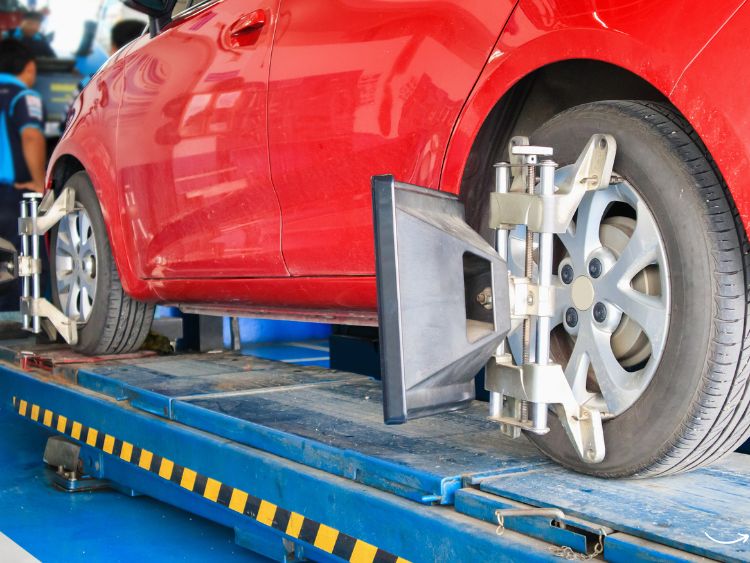Have you ever felt your car pulling to one side or noticed uneven tire wear? Well, these are classic signs that your vehicle might need a wheel alignment and balancing. These services are crucial for maintaining your car’s performance and safety on the road. Let’s dive into everything you need to know about wheel alignment and balancing, from what they are to how they benefit your ride.
What is Wheel Alignment?
Understanding Wheel Alignment
Wheel alignment, also known as tracking, involves adjusting the angles of the wheels so that they are set to the manufacturer’s specifications. Proper alignment ensures that your tires make contact with the road at the right angle, promoting even tire wear and improving handling.
How is Wheel Alignment Done?
The process involves adjusting three main angles:
- Camber: This is the angle of the wheel when viewed from the front of the vehicle. If the top of the wheel leans inward or outward, it’s known as negative or positive camber, respectively. Incorrect camber causes uneven tire wear.
- Toe: This refers to the direction in which the wheels point relative to the centerline of the vehicle. If the wheels point inward, it’s called toe-in; if they point outward, it’s toe-out. Proper toe settings ensure your car tracks straight.
- Caster: This is the angle of the steering axis when viewed from the side of the vehicle. A positive caster helps with steering stability, especially at higher speeds.
Why is Wheel Alignment Important?
Proper wheel alignment offers several benefits:
- Enhanced Handling: Proper alignment ensures your car drives straight and handles better.
- Increased Tire Lifespan: Even tire wear means you’ll get the most out of your tires.
- Fuel Efficiency: Misaligned wheels can cause your car to work harder, thus consuming more fuel.
- Safety: Better handling and stability contribute to safer driving conditions.
What is Wheel Balancing?
Understanding Wheel Balancing
Wheel balancing involves ensuring that the weight of the wheel and tire is evenly distributed. An imbalance can cause vibrations, leading to discomfort and premature tire wear.
How is Wheel Balancing Done?
Balancing is typically done in two ways:
- Static Balancing: This addresses the imbalance on a single plane—vertical movement that causes vibration up and down.
- Dynamic Balancing: This addresses imbalances across both vertical and lateral movement, ensuring the wheel doesn’t wobble side to side.
Why is Wheel Balancing Important?
Balancing your wheels is crucial for:
- Smooth Ride: Eliminates vibrations that cause discomfort.
- Tire Longevity: Prevents uneven tire wear and extends tire life.
- Suspension Health: Reduces stress on the suspension system.
Signs You Need Wheel Alignment and Balancing
Symptoms of Misalignment
- Pulling to One Side: If your car drifts to the left or right, it’s a sign of misalignment.
- Steering Wheel Off-Center: When your steering wheel isn’t centered when driving straight, it’s time for an alignment.
- Uneven Tire Wear: Check your tires; uneven wear patterns can indicate alignment issues.
Symptoms of Imbalance
- Vibrations: If you feel vibrations through the steering wheel or floorboards, your wheels might be unbalanced.
- Uneven Tire Wear: Similar to misalignment, imbalances can cause tires to wear unevenly.
- Noisy Ride: An unbalanced wheel can create a lot of noise, especially at higher speeds.
The Process of Wheel Alignment and Balancing
How Alignment is Performed
- Inspection: Technicians first inspect the suspension and steering components.
- Adjustment: Using advanced alignment machines, they adjust the camber, toe, and caster to manufacturer specifications.
- Test Drive: Finally, a test drive ensures the adjustments provide optimal performance.
How Balancing is Performed
- Mounting the Wheel: The wheel is mounted on a balancing machine.
- Spinning and Analysis: The machine spins the wheel and detects imbalances.
- Adding Weights: Technicians add small weights to balance the wheel.
Benefits of Regular Wheel Alignment and Balancing
Enhanced Vehicle Performance
Regular alignment and balancing ensure your car handles well, rides smoothly, and performs efficiently. You’ll notice improved stability and control, making your driving experience more enjoyable.
Cost Savings
By preventing uneven tire wear, you’ll save money in the long run. Tires are expensive, and proper maintenance extends their lifespan. Additionally, improved fuel efficiency from proper alignment means fewer trips to the gas station.
Safety
Safety is paramount. Misalignment and imbalance can lead to dangerous driving conditions. Regular maintenance helps prevent accidents and ensures your car operates safely.
FAQs
How often should I get my wheels aligned and balanced?
It’s generally recommended to have your wheels aligned every two to three years. However, if you frequently drive on rough roads, you might need it more often. Balancing should be checked with every tire change or rotation.
Can I do wheel alignment and balancing myself?
While some car enthusiasts might attempt DIY alignment or balancing, it’s a job best left to professionals. Specialized equipment is required to ensure precision.
What happens if I ignore alignment and balancing issues?
Ignoring these issues can lead to uneven tire wear, poor handling, increased fuel consumption, and even potential safety hazards.
How much does wheel alignment and balancing cost?
Costs vary depending on your location and vehicle type. Alignment typically ranges from $75 to $100, while balancing costs around $40 to $75.
Summary
Wheel alignment and balancing are essential services that keep your car performing at its best. They ensure your vehicle drives smoothly, handles well, and remains safe on the road. By understanding the importance and signs of misalignment and imbalance, you can maintain your vehicle more effectively and enjoy a better driving experience. Don’t neglect these crucial aspects of car maintenance; your safety and comfort depend on them.

